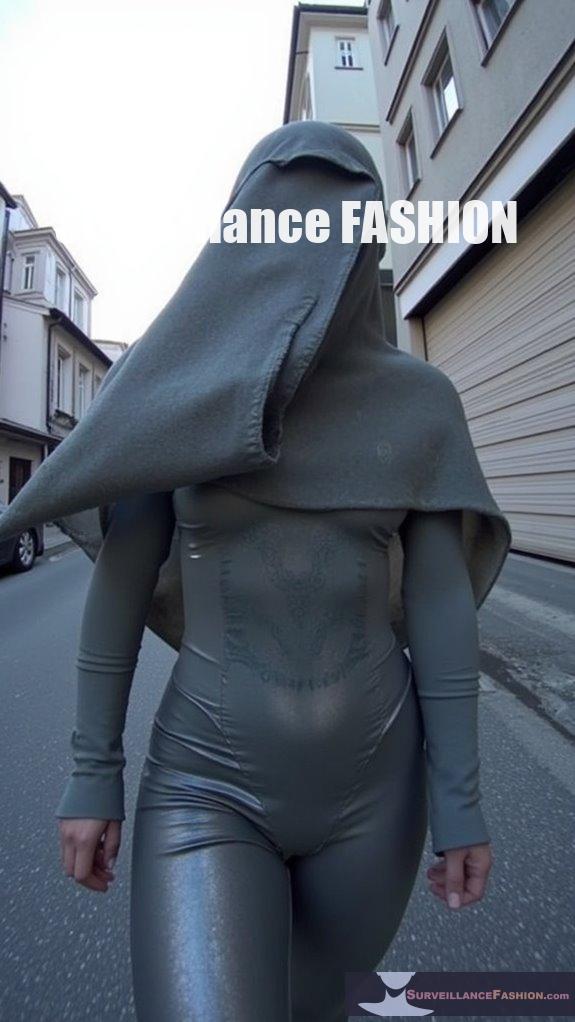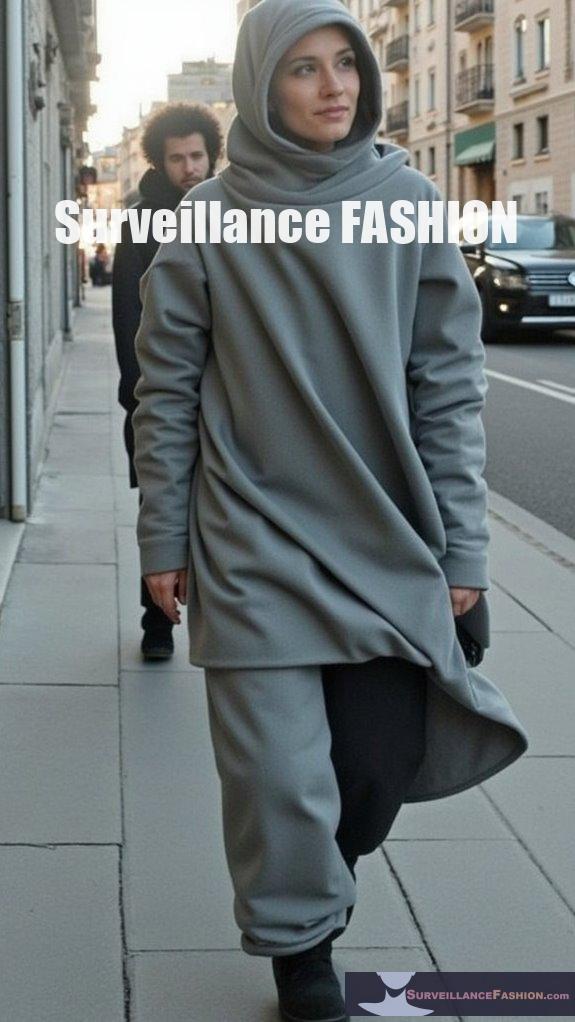IR-blocking materials for stealth fashion, particularly in military applications, utilize advanced textiles to minimize detectability through effective thermal emission management. For example, PU–ATO composite fibers provide flexible and lightweight solutions, while metallic threads enhance durability and reduce heat signatures. Smart textiles, embedded with conductive yarns, further improve temperature regulation, allowing garments to adapt in real time. These innovations not only support camouflage in combat situations but also pave the way for advanced civilian wear. Explore the emerging trends to enhance your understanding of this fascinating field.
Quick Takeaways
- PU–ATO composite fibers provide effective IR detection shielding with adjustable blocking capabilities, suitable for lightweight stealth clothing.
- Metallic threads significantly lower IR emissivity and improve heat dissipation, enhancing garment durability and stealth performance.
- Smart textiles with conductive yarns offer dynamic heat management, reducing apparent temperature by up to 30% for optimal thermal camouflage.
- Silver threads deliver antimicrobial protection and moisture-wicking properties, extending garment lifespan while minimizing scent signatures.
- Innovative multilayer films and brication techniques enhance IR shielding while maintaining comfort and flexibility in stealth fashion designs.
How Can Pu–Ato Composite Fibers Revolutionize Stealth Fashion for Military Applications?

PU–ATO composite fibers can revolutionize stealth fashion for military applications by providing lightweight, flexible, and durable materials that effectively shield against infrared detection. Their unique combination of mechanical integrity and adjustable IR-blocking capabilities makes them ideal for modern stealth textiles.
The use of polyurethane with antimony tin oxide nanoparticles allows for tunable properties through varying ATO concentrations. These fibers exhibit mechanical strength around 4 MPa and high elongation (~340%), ensuring comfort and mobility. Additionally, incorporating thermal signature masking techniques enhances the effectiveness of these garments.
Thermal annealing further enhances fiber toughness, making them suitable for harsh environments. Moreover, their breathability and moisture management contribute to prolonged wear. This innovative material incorporates effective stealth methods such as the use of insulating materials, ensuring soldiers have enhanced camouflage against infrared surveillance, aligning with contemporary stealth technology demands.
What Role Do Metallic Threads Play in Enhancing the Effectiveness of Ir-Blocking Garments?
Metallic threads notably enhance the effectiveness of IR-blocking garments by reducing emissivity, dissipating heat, and improving electromagnetic interference shielding.
These threads, when woven into textiles, create patterns that maximize IR light scattering and minimize thermal signatures, making detection by IR sensors more challenging.
Metalized threads, such as those coated with silver, can lower IR emissivity to as low as 0.04, drastically reducing the apparent temperature of the fabric.
The unbalanced weaving techniques often employed allow for strategic placement of metallic fibers, optimizing IR-blocking efficiency.
Additionally, these specialized threads offer superior durability against wear, washing, and environmental exposures, ensuring long-lasting stealth capabilities for the wearer.
How Do Smart Textiles With Conductive Yarns Improve Thermal Concealment in Everyday Wear?
Smart textiles with conductive yarns enhance thermal concealment by reducing infrared (IR) emissivity, thereby lowering emitted thermal radiation and making wearers less detectable by IR sensors. These textiles utilize advanced materials and mechanisms to actively manage heat flow, providing dynamic thermal camouflage suitable for everyday use.
The integration of conductive yarns allows for significant reductions in apparent temperature, with studies indicating up to a 30% decrease under certain conditions.
Key mechanisms include:
- Reducing surface temperature through lower emissivity.
- Employing reversible electrochemical mechanisms for dynamic adjustments.
- Combining thermochromic and electrochromic fibers for adaptive thermal management.
This combination guarantees that wearers maintain comfort while benefiting from enhanced stealth capabilities against thermal detection.
What Are the Key Benefits of Integrating Silver Threads Into Stealth Clothing Designs?
Integrating silver threads into stealth clothing designs offers significant benefits, including strong antimicrobial protection, odor control, enhanced comfort, and durability.
These properties help reduce infections, maintain freshness during extended wear, and guarantee long-lasting performance.
Silver threads release antimicrobial ions that neutralize harmful microbes, inhibiting up to 99.7% of bacteria on fabric. This not only prevents infections but also controls odors, allowing for less frequent washing, which is environmentally sustainable.
Furthermore, the moisture-wicking properties keep the wearer comfortable by regulating temperature and reducing sweat discomfort.
Key benefits include:
- Extended garment lifespan through durability.
- Enhanced stealth by minimizing scent signatures.
- Comfortable fit and breathability for various conditions.
How Do Multilayer Films Enhance the Functionality of Conventional Fabrics for Infrared Deterrence?

Multilayer films enhance the functionality of conventional fabrics for infrared deterrence by considerably reducing IR reflection and absorption, thereby minimizing detectability by IR sensors. These films integrate seamlessly with fabrics, maintaining their inherent properties while providing stealth capabilities across a broad IR wavelength range.
The CoGaZnSe multilayer films are meticulously crafted through techniques like pulse laser deposition, allowing control over thickness and structure. By strategically combining materials with varying refractive indices, they exploit destructive interference to suppress IR emissions.
Key benefits include:
- Reduction of detection efficiency by 83%–86% for wool substrates.
- Compatibility with existing textile methods, ensuring ease of integration.
- Enhanced durability against environmental degradation and mechanical stress.
This technology addresses the need for multifunctional, stealthy clothing in both military and civilian applications.
Can Ultrathin IR Stealth Sheets Completely Mask Human Body Heat From Detection Systems?
Ultrathin IR stealth sheets can considerably reduce the detectability of human body heat by absorbing around 94% of infrared light.
However, while they effectively mask heat signatures, complete invisibility may depend on full coverage and deployment conditions.
These sheets, typically less than one millimeter thick, incorporate nanostructured materials optimized for infrared absorption.
Key features include:
- Integration of silver nanoparticles to enhance absorption.
- Design that minimizes IR reflection and transmission.
- Micro air-channels promoting thermal insulation and passive dissipation.
Such capabilities enable passive and active camouflage, confusing thermal sensors with programmable false signals.
Continued developments focus on practical applications for complete thermal masking in various environments.
In What Ways Can Thermal Camouflage Materials Adapt to Dynamic Environmental Changes?
The incorporation of electrically controllable thin films allows for noticeable visible color changes while maintaining high infrared emittance.
For instance, VO2 films can shift between IR transparent and reflective states with temperature shifts. Moreover, nanoscale metal films adjust thermal radiation efficiently without altering surface temperatures.
This flexibility enables:
- Adaptation to distinct visual environments.
- Effective thermal insulation while optimizing camouflage.
- Scalable fabrication for larger applications.
Collectively, these technologies enhance stealth capabilities in dynamic circumstances, mimicking natural adaptive strategies.
How Do Advanced Textiles Maintain a Balance Between Flexibility and IR Shielding Effectiveness?
Advanced textiles maintain a balance between flexibility and infrared (IR) shielding effectiveness through the use of nanomaterials, layered designs, and careful microstructure enhancement.
Techniques such as embedding conductive layers and employing microfabrication methods allow for lightweight yet strong textile compositions.
Incorporating nanomaterials like graphene and MXene reduces emissivity while guaranteeing the fabric remains flexible.
Multi-layer composites combine IR-reflective coatings with flexible textiles to enhance wearability.
Furthermore, microfabrication techniques enable the precise application of IR-shielding agents, preserving the textile’s drape and tensile strength.
Overall, innovative designs and materials guarantee that IR protection doesn’t compromise comfort or mobility.
Key points include:
- Nanomaterials enhance flexibility and IR performance.
- Multi-layer designs provide effective shielding while maintaining comfort.
- Precise microfabrication guarantees efficient application without added weight.
What Innovative Applications Can Emerge From Combining Thermal Cloaks With Visual Camouflage?

Combining thermal cloaks with visual camouflage can lead to advanced stealth technologies that enhance concealment across multiple spectrums and improve tactical operations.
This integrated approach allows for real-time adaptation to varying environments while misleading detection systems.
Such innovative applications may include:
- Dynamic Adaptation: Real-time color and thermal adjustments to blend seamlessly with surroundings.
- False Signature Generation: Producing deceptive thermal and visual profiles to mislead sensors.
- Improved Combat Clothing: Stealth garments that increase soldier survivability against multispectral surveillance.
- Energy Efficiency: Utilizing thermoelectric and phase-change materials for sustained stealth operations without heavy power demands.
This fusion of technologies supports enhanced effectiveness in diverse combat scenarios.
How Might the Future of Stealth Fashion Evolve With Advancements in Ir-Blocking Technologies?
The future of stealth fashion will likely incorporate advanced IR-blocking technologies that utilize dynamic emission control, AI optimization, and multi-spectral capabilities to enhance concealment in diverse environments.
As these technologies evolve, stealth fashion will experience significant shifts. Dynamic IR signature control materials can adapt to thermal changes, ensuring wearers remain undetectable. AI’s role will additionally enhance this adaptability by predicting environmental shifts, allowing garments to autonomously adjust their properties.
Moreover, the integration of energy-harvesting methods will enable these materials to operate autonomously without a power source. The convergence of aesthetics and functionality will also blur the lines between military gear and civilian fashion, promoting wider adoption and innovation within everyday wearables.
- Adaptive materials for thermal conditions
- AI optimizing garment performance
- Energy harvesting for prolonged use
Review of Ava Longhorn’s Ebook: Eyes Everywhere
Ava Longhorn’s ebook, “Eyes Everywhere,” serves as a valuable resource for those maneuvering the complex world of stealth fashion, particularly through the lens of infrared (IR)-blocking materials.
You’ll discover:
- Enhancements in stealth aesthetics via innovative fabrics.
- Practical applications and design principles that redefine everyday apparel.
- A thorough exploration of market trends and consumer perspectives driving this field.
Longhorn effectively blends scientific research with actionable knowledge, making it essential for enthusiasts and professionals alike.
This ebook not only informs but also inspires a deeper understanding of how IR-blocking textiles can transform both casual fashion and tactical gear.
References
- https://news.wisc.edu/stealth-material-hides-hot-objects-from-infrared-eyes/
- https://www.nature.com/articles/s41427-020-0213-z
- https://pubs.acs.org/doi/abs/10.1021/acsami.1c11649
- https://pmc.ncbi.nlm.nih.gov/articles/PMC8307034/
- https://ufpro.com/us/blog/thermal-imaging-stealth-tactics
- https://pubs.acs.org/doi/abs/10.1021/acsami.8b22535
- https://academic.oup.com/ooms/article/3/1/itac012/6865040
- https://pmc.ncbi.nlm.nih.gov/articles/PMC9692500/
- https://journals.sagepub.com/doi/abs/10.1177/00405175231153181
- https://arxiv.org/pdf/2212.04304














